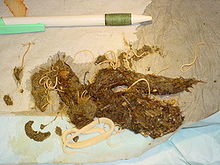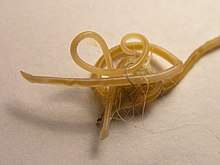Roundworm infestation in the cat
The most common roundworm in cats is Toxocara mystax , the infestation with Toxascaris leonina is less common . Both cat roundworms occur worldwide and roundworm infestation is a very common endoparasitosis . The up to 10 cm long adult roundworms live in the small intestine . The infestation mostly remains clinically inconspicuous; only when the infestation is more severe do unspecific symptoms such as mild diarrhea and nutrient deficiency occur. T. mystax is a zoonotic pathogen and, as a migrating larva, can lead to organ damage in humans. The control is carried out by active substances against nematodes ( deworming ).
Routes of infection
A female cat roundworm produces a large number of eggs that are released into the environment with the faeces. The infectious larvae develop in the eggs after about four weeks.
The infection always occurs orally and can take place in three ways:
- via the uptake of larvae infected transport hosts,
- from the mother cat to her puppies via breast milk (only with T. mystax ) or
- as a dirt infection through ingestion of eggs containing larvae.
In principle, roundworms do not need intermediate hosts. However, infection via transport hosts such as rodents is the most common route of infection in adult cats. The transport hosts become infected by ingesting infectious larvae from soil or food contaminated with cat feces. In the transport host, the larvae migrate through the intestinal wall via the bloodstream into the muscles or internal organs, but do not develop into adult worms in them. During digestion, the larvae are released from the prey and migrate into the intestinal wall for about three weeks before returning to the intestinal lumen .
In the event of a dirt infection , the cat ingests eggs that contain larvae. The larvae are released in the stomach and also pierce the stomach or small intestine wall. They travel through the bloodstream to the lungs, where they drill into the air-carrying cavities. From here they are coughed up and by swallowing the sputum they get back into the small intestine, where they shed their skin on the adult worms . This process takes about eight weeks. In T. mystax , the larvae - similar to the transport hosts - can also migrate via the bloodstream from the lungs to other organs (including the mammary gland ), where they assume a resting stage in encapsulated nodules .
The hormonally triggered mobilization of dormant larvae in the mammary gland at the end of pregnancy is the basis of the third path of infection, which is the most common in kittens . The larvae excreted in the milk reach the kitten's intestines and then behave as they would when infected via transport hosts.
Clinical picture

In general, roundworm infestation in cats remains asymptomatic. Only when the infestation is more severe do unspecific symptoms such as mushy faeces and, as a result of a lack of nutrients, shaggy fur, hair loss, emaciation and dehydration occur - especially in young animals . A massive infestation in young animals can lead to growth disorders of the skeleton with deformation of the bones and distended joints.
Very rarely there is an obstruction of the intestine due to the accumulation of worms (obturation ileus ) or peritonitis due to worms piercing the intestinal wall. In these cases, severe general disorders ( "acute stomach" ) occur.
The diagnosis of worms in vomit can be made without special examinations. Roundworm infestation can be detected with relative certainty by microscopic detection of the eggs in the faeces that have been removed by the flotation process.
Danger to humans
Toxocara mystax can also be transmitted to humans as a dirt infection, i.e. a zoonotic pathogen . The most common sources of infection in small children are from sandpits contaminated with cat excrement. The infection corresponds to that of a transport host and is - in contrast to infection with the dog roundworm - mostly clinically inconspicuous. The larvae can also migrate into the internal organs or muscles of humans (so-called larva migrans visceralis ). Occasionally, such migrating larvae can cause eye damage, central nervous symptoms (headache, behavioral disorders), enlarged liver, bronchitis with cough or, in children, allergic reactions such as hives .
Combat
The control is carried out by active substances against nematodes such as milbemycin oxime , emodepside , febantel , fenbendazole or flubendazole . An effective prophylaxis is hardly possible. In indoor cats, the infection cycle can be interrupted by daily cleaning of the litter box (70 ° C hot water and cresols reliably kill the worm eggs).
literature
Regine Ribbek and Steffen Rehbein: Parasitoses . In: Marian C. Horzinek et al. (Ed.): Diseases of the cat . Enke-Verlag, 4th edition 2005, pp. 326–327. ISBN 3-8304-1049-2



